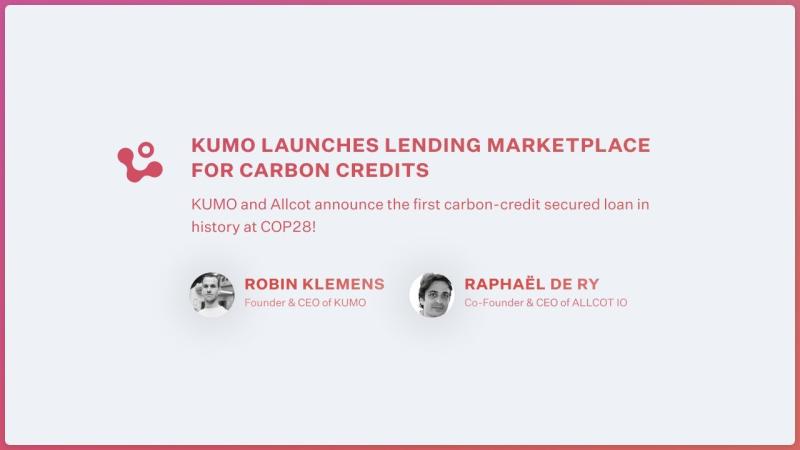Unlocking The Value Of Carbon With Robin Klemens │ S3Ep17 🎧
Diving into finance's future with KUMO's CEO Robin Klemens. This episode of ReFi Podcast reveals KUMO's innovative approach, using tokenized carbon credits for loans, focusing on environmental sustainability. This pioneering concept is attracting attention from giants like Morgan Stanley.

How might the integration of carbon credits into mainstream banking catalyze a shift towards more sustainable, nature-centric economic models?
Today, we are excited to share insights from the latest episode of the ReFi Podcast, where host John Ellison sits down with Robin Klemens, the visionary CEO and founder of KUMO, a lending marketplace redefining the financial landscape with its approach to environmental sustainability.
KUMO's journey began with a bold vision: to transform the very concept of money into a force for good, allowing individuals to use a currency that not only facilitates transactions but actively contributes to protecting and restoring nature. KUMO has evolved from a natural capital-backed stable coin project into a pioneering lending marketplace, where people can use tokenized carbon credits to secure loans in FIAT currencies like US dollars or Euros. Its innovative lending model is a game-changer for project developers in the voluntary carbon market and has caught the eye of top-tier banks Morgan Stanley.
In this episode, you will:
🌱 Learn about KUMO's transformation from a natural capital-backed stablecoin to an innovative lending protocol using carbon credits.
🏦 Discover how KUMO's approach is attracting top-tier banks to invest in nature as a valuable asset in their portfolios.
💡 Gain insights into the challenges of climate change and how regenerative finance is evolving to meet these challenges using Web3 technologies.
Revolutionizing Climate Finance With A Unique Lending Marketplace

KUMO is uniquely designed to bridge the gap between project developers in the voluntary carbon market and climate financiers. KUMO's pioneering approach involves collateralizing both spot and forward carbon credits to provide secure loans. This model significantly reduces the financial risks and lowers costs associated with climate projects, thereby making a substantial impact on the climate finance barriers.

An important aspect of KUMO's launch is its attraction of institutional capital. This is a critical indicator of the platform's potential and credibility. Institutional investors' interest in KUMO underscores the growing recognition of the importance of sustainable and regenerative investments. It signals a paradigm shift in how financial markets view and engage with climate-related projects, moving from a niche interest to a mainstream financial consideration.

KUMO represents a significant breakthrough in the world of ReFi. Its innovative lending model, focused on carbon credit collateralization, is a game-changer for project developers in the voluntary carbon market.
COP 28: A Milestone For KUMO And The Carbon Market
COP 28 emerged as a pivotal event for KUMO, marking a significant moment in the journey of addressing the urgent needs of project developers within the carbon market. The United Nations' conference underscored a revelation: the financial industry's interest in the carbon markets. This interest was previously uncertain, especially given the market's imperfections and associated risks. However, the appetite for involvement in these markets has become increasingly evident, much to the benefit of project developers who are in dire need of funding.
KUMO launches a lending marketplace for carbon credits live from COP28 and takes the first step to unlock $10 Billion in dormant value to help bridge the sustainable finance GAP! Watch this video to see history take place!https://t.co/OcjywPmbFK
— KUMO (@kumo_earth) December 20, 2023
Traditionally, these developers had limited options: either resort to expensive equity money or pre-sell their carbon credits at substantial discounts. Such pre-purchase agreements often led to project developers merely functioning as service providers, without the ability to participate in any potential appreciation of their credits. KUMO's introduction of an alternative funding solution at COP 28 provided a breath of fresh air for these developers. It offered them a way to leverage future emissions as collateral, thereby gaining better access to funding while still engaging actively in the market.
This episode covers:
[00:02:34] Check-in With Robin
[00:03:24] What Is KUMO?
[00:04:01] The Original Vision Of A Nature-Backed Currency
[00:07:48] The Obstacles In Bringing The Vision To Life
[00:18:20] The Market Response & COP28
[00:22:54] AHA Moments With Institutional Actors
[00:29:04] The Composability Layer
[00:37:06] The Partnership With Solid World
[00:39:00] Unpacking The Black Hat
[00:46:31] What’s Coming Next?
[00:49:48] Unlicking A Unique Value
[00:55:11] Staying Centered And Grounded
Join The Conversation ✨
Can a nature-backed currency truly revolutionize our approach to regeneration, transforming financial transactions into acts of environmental restoration?
Join the discussion on Twitter and LinkedIn! Did you enjoy this episode? We would be incredibly grateful it if you could show your support by leaving a five-star review on your favourite podcast platform. ⭐⭐⭐⭐⭐
Wishing you all a year of positive change! 💚

